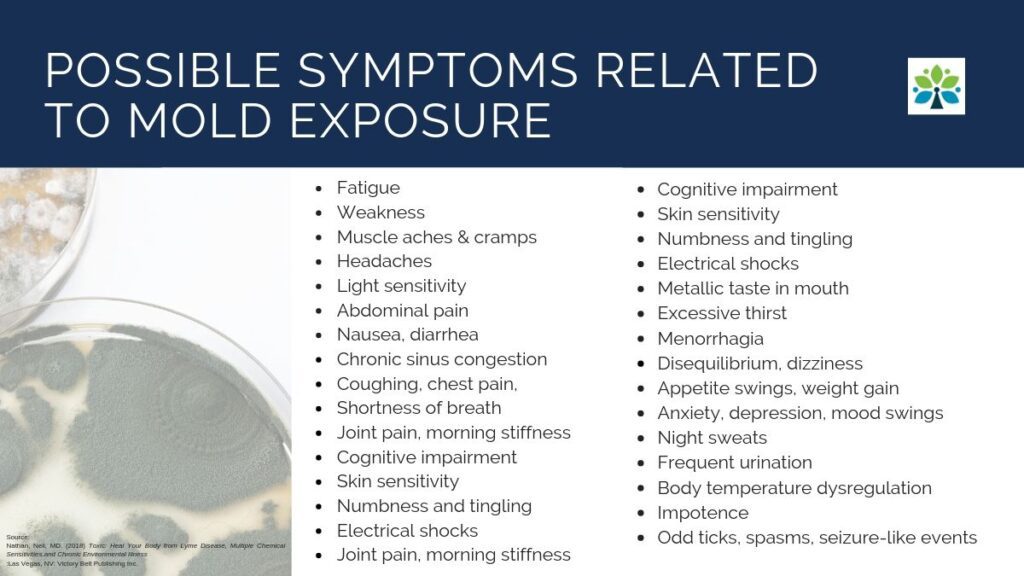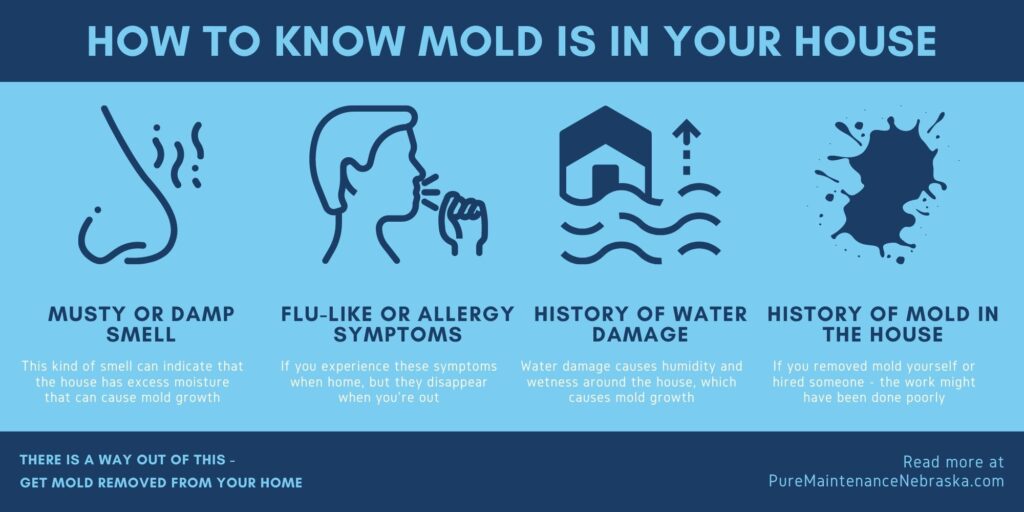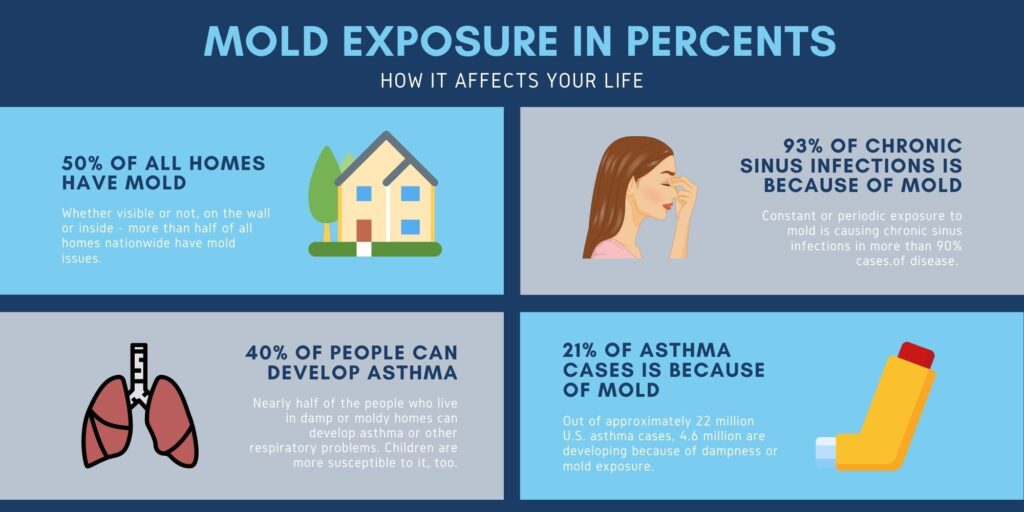Have you ever wondered about the potential health effects of prolonged exposure to mold? It is crucial to be aware of the symptoms associated with long-term exposure to mold and how they can impact your overall well-being. Mold, a type of fungus that thrives in damp and humid environments, can be found in various places such as homes, offices, and schools. If you have been exposed to mold for an extended period, it’s vital to recognize the potential health consequences it can have on your body.
One common symptom of long-term exposure to mold is respiratory issues. You may experience persistent coughing, wheezing, or shortness of breath. These respiratory problems may become persistent and even worsen over time if the mold exposure continues. Additionally, individuals exposed to mold for long periods may develop allergic reactions, such as sneezing, itching, or a runny nose. These symptoms can be bothersome and may impact your day-to-day life if left untreated.
It is essential to pay attention to any changes in your health if you suspect long-term exposure to mold. If you are experiencing any persistent respiratory problems or allergic reactions, it is recommended that you seek medical attention to determine the underlying cause and receive appropriate treatment. Remember, early recognition of the symptoms associated with long-term mold exposure is key to safeguarding your health in the long run.
Overview
Understanding long-term exposure to mold is crucial for recognizing the potential health impact it can have on individuals. Mold is a type of fungi that thrives in damp and humid environments, such as basements, bathrooms, and poorly ventilated areas. While mold exposure is common and often harmless in small amounts, prolonged exposure can lead to a range of physical and psychological symptoms that should not be ignored. By being aware of the hidden dangers of prolonged mold exposure, individuals can take necessary precautions and seek medical help to mitigate the adverse effects on their health.
Physical Symptoms
Respiratory issues
One of the most common physical symptoms associated with long-term mold exposure is respiratory issues. Continuous exposure to mold spores in the air can irritate the respiratory system, leading to coughing, wheezing, and difficulty in breathing. Individuals with pre-existing respiratory conditions like asthma may experience worsening symptoms, including frequent asthma attacks. Even those without prior respiratory issues can develop new respiratory problems due to prolonged mold exposure.
Allergic reactions
Mold spores are known allergens, capable of triggering allergic reactions in susceptible individuals. People who are allergic to mold may experience symptoms such as sneezing, runny nose, itchy throat, and congestion. These allergic reactions can persist or worsen over time as a result of continuous exposure to mold, leading to chronic allergy symptoms.
Skin irritations
Prolonged exposure to mold can also cause various skin irritations. Individuals may develop rashes, dermatitis, or hives, with symptoms ranging from mild to severe. Skin itching and redness are often observed in areas that have come into direct contact with mold-infested surfaces. These skin issues can be particularly bothersome and may require medical attention and appropriate treatment.
Persistent headaches
Headaches can be a common physical manifestation resulting from long-term mold exposure. The exact mechanism behind these headaches is not fully understood, but various factors, such as inflammation in the sinuses, nasal congestion, and the release of mycotoxins by certain molds, could contribute to their development. These persistent headaches can significantly impact an individual’s quality of life and overall well-being.
Chronic fatigue
Feeling constantly exhausted and fatigued is another symptom that can arise from long-term mold exposure. Mold spores in the air can lead to an increased production of inflammatory substances in the body, which can disrupt normal physiological processes and result in chronic fatigue. Individuals may struggle to maintain their energy levels, experience difficulty concentrating, and find it challenging to carry out daily activities.
Nausea and digestive problems
In some cases, long-term mold exposure can affect the digestive system, leading to symptoms such as nausea, vomiting, and chronic diarrhea. These gastrointestinal issues may occur due to the ingestion of mold spores or mycotoxins present on food or from the inhalation of mold particles that can irritate the digestive tract. Identifying and eliminating the source of mold is crucial in alleviating these digestive problems.

Psychological Symptoms
Depression and anxiety
Long-term mold exposure can also have significant psychological effects on individuals. Depression, anxiety, and other mood disorders may develop or worsen as a result of the constant presence of mold in the environment. The exact mechanisms behind this association are complex and not yet fully understood, but it is believed that inflammatory responses triggered by mold exposure can directly impact the brain, leading to changes in mood and behavior.
Mood swings
Individuals exposed to mold for extended periods may experience fluctuations in mood, leading to frequent mood swings. These mood swings can range from sudden bouts of irritability and anger to periods of sadness and emotional instability. Mold-related mood swings can significantly impact interpersonal relationships and overall mental well-being.
Memory and concentration problems
Cognitive functions, such as memory and concentration, may be negatively affected by long-term mold exposure. Difficulty in remembering things, decreased ability to focus, and impaired cognitive performance are commonly reported symptoms. These cognitive impairments can interfere with daily tasks, work, and academic performance, leading to frustration and decreased productivity.
Sleep disturbances
Individuals exposed to mold may also experience sleep disturbances and insomnia. Mold spores in the air can trigger respiratory issues and allergic reactions, which can disrupt normal sleep patterns. Poor quality sleep can further contribute to fatigue, irritability, and additional physical and psychological symptoms. Addressing the underlying mold issue is crucial in promoting better sleep hygiene and overall well-being.
Increased irritability
The constant presence of mold in one’s living or working environment can lead to increased irritability. Mold-related physical symptoms, sleep disturbances, and the overall discomfort associated with prolonged exposure may contribute to feelings of frustration, impatience, and a decreased tolerance for stress. Recognizing and addressing the underlying mold problem can help alleviate these irritability issues.
Respiratory System Impact
Worsening of existing respiratory conditions
Individuals with pre-existing respiratory conditions, such as asthma or chronic bronchitis, may experience a worsening of their symptoms with long-term mold exposure. Mold spores in the air can trigger inflammation in the airways, leading to increased coughing, wheezing, and shortness of breath. It is important for individuals with these conditions to be aware of the potential impact of mold and take steps to reduce exposure.
Development of respiratory infections
Prolonged mold exposure can also increase the risk of developing respiratory infections. Mold spores, when inhaled, can reach the lungs and cause inflammation and damage to the respiratory system. This weakened defense mechanism can make individuals more susceptible to respiratory infections, such as bronchitis or pneumonia. Recognizing the connection between mold exposure and respiratory infections is essential for seeking proper treatment and taking preventive measures.
Long-term damage to the lungs
Exposure to mold over an extended period may lead to long-term damage to the lungs. In severe cases, mold exposure can contribute to the development of conditions like hypersensitivity pneumonitis or mold-induced asthma. Such lung diseases can have significant implications for an individual’s respiratory health, requiring specialized medical attention and long-term management.

Allergic Reactions
Increased severity of allergies
For individuals with allergies, long-term mold exposure can exacerbate their symptoms and increase the severity of their allergic reactions. The presence of mold spores in the air can trigger heightened immune responses, leading to more pronounced allergic symptoms. Hay fever, allergic rhinitis, and other allergic conditions may become more challenging to manage, requiring additional medical interventions and lifestyle adjustments.
Development of new allergies
In addition to worsening existing allergies, long-term mold exposure can potentially lead to the development of new allergies. The immune system’s continuous exposure to mold spores can result in sensitization to other allergens, causing individuals to develop allergies to substances they were previously unaffected by. This highlights the importance of recognizing mold as a potential allergy trigger and taking appropriate measures to reduce exposure.
Asthma exacerbation
Individuals with asthma may experience an exacerbation of their symptoms due to long-term mold exposure. The presence of mold spores in the environment can trigger asthma attacks, characterized by wheezing, coughing, chest tightness, and shortness of breath. It is crucial for individuals with asthma to be aware of the connection between mold and their respiratory condition, ensuring prompt management and control of their symptoms.
Skin and Eye Issues
Rashes and dermatitis
Direct contact with mold-infested surfaces or exposure to mold spores can lead to the development of rashes and dermatitis on the skin. Itchy, red, and irritated skin may appear after prolonged exposure, particularly in sensitive individuals. Identifying and addressing the mold source, along with appropriate skin care measures, can alleviate these skin issues.
Itchy or watery eyes
Mold spores in the air can also cause eye irritation, leading to symptoms such as itching, redness, and excessive tearing. Individuals may experience discomfort and difficulty focusing due to irritated and watery eyes. Taking steps to reduce mold exposure, such as improving ventilation and thorough cleaning, can help alleviate these eye-related problems.
Conjunctivitis
Conjunctivitis, also known as pink eye, can develop as a result of prolonged mold exposure. The conjunctiva, a thin layer covering the white part of the eye and the inner surface of the eyelids, can become inflamed and infected when exposed to mold spores. The symptoms include redness, itchiness, excessive tearing, and a gritty sensation in the eyes. Seeking prompt medical attention and addressing the underlying mold issue is essential in treating and preventing the recurrence of conjunctivitis.

Neurological Effects
Cognitive impairment
Long-term mold exposure has been associated with cognitive impairments, such as difficulties with memory, concentration, and problem-solving abilities. The inflammation and neurotoxicity triggered by mold exposure can disrupt normal brain function, impacting cognitive processes. Recognizing these neurological effects and seeking prompt medical evaluation is essential in managing such impairments effectively.
Neurotoxicity
Exposure to certain molds can lead to the production and release of mycotoxins, which are toxic chemicals. These mycotoxins have the potential to cause neurotoxic effects, affecting the central nervous system and neurological functions. Symptoms of neurotoxicity may include dizziness, confusion, sensory disturbances, and coordination problems. Individuals experiencing these symptoms should consult a healthcare professional for appropriate evaluation and management.
Headaches and migraines
Headaches and migraines are common neurological symptoms associated with long-term mold exposure. The exact mechanisms behind the development of these headaches are not fully understood. However, it is believed that mold-induced inflammation, activation of the trigeminal nerve, and the release of certain chemical mediators can contribute to their occurrence. Proper diagnosis and management of these headaches, including addressing the underlying mold issue, can help alleviate the discomfort.
Digestive System Complications
Nausea and vomiting
Some individuals exposed to mold for an extended period may experience episodes of nausea and vomiting. Ingestion of mold spores or mycotoxins present on food or in the environment can irritate the digestive system, leading to these gastrointestinal symptoms. Proper food handling practices, mold remediation, and seeking medical evaluation are essential in managing and alleviating these complications.
Abdominal pain
Abdominal pain can be a common digestive symptom associated with long-term mold exposure. The exact mechanisms behind this discomfort are not well understood. However, it is hypothesized that mold-related inflammation, immune system responses, and the release of inflammatory mediators can contribute to abdominal pain. Individuals experiencing persistent abdominal pain should consult a healthcare professional for appropriate evaluation and management.
Chronic diarrhea
Prolonged exposure to mold can also lead to chronic diarrhea in some individuals. The irritation of the digestive tract, combined with the potential ingestion of mold-contaminated food or beverages, can result in frequent loose stools. Managing mold exposure, maintaining good hygiene practices, and seeking medical advice can help address and alleviate chronic diarrhea.

Immune System Dysfunction
Weakened immune response
Continuous mold exposure can lead to immune system dysregulation and weakening. Mold spores and mycotoxins can trigger immune responses, including the release of inflammatory mediators, which can disrupt normal immune function. Consequently, individuals may become more susceptible to infections and experience difficulty recovering from illnesses. Strengthening the immune system through a healthy lifestyle and addressing mold exposure is crucial in restoring immune function.
Increased susceptibility to infections
Prolonged mold exposure can increase an individual’s susceptibility to various infections, both respiratory and systemic. Weakened immune responses, respiratory inflammation, and compromised barriers can make individuals more vulnerable to bacterial, viral, and fungal infections. Prompt detection and treatment of these infections, alongside mold remediation, are essential in minimizing the overall health impact.
Influence on Children’s Health
Respiratory issues in children
Children, particularly infants and young children, are more susceptible to the health effects of mold exposure. Prolonged exposure to mold can lead to the development or worsening of respiratory issues in children, such as asthma and allergies. It is crucial for parents and caregivers to maintain a mold-free environment and seek appropriate medical care if respiratory symptoms arise.
Developmental delays and learning difficulties
Long-term mold exposure may also have an impact on children’s cognitive development. Research suggests that exposure to mold during critical periods of brain development can contribute to developmental delays and learning difficulties. It is important for parents, healthcare professionals, and educators to be aware of the potential influence of mold exposure on children’s health and seek early interventions when necessary.
Impact on immune system development
The immune system of children is still developing, making them more vulnerable to the health effects of mold exposure. Prolonged exposure to mold during childhood can potentially impact the proper development and functioning of the immune system, leading to increased susceptibility to infections and allergies. Creating a mold-free environment, promoting healthy habits, and seeking medical guidance is crucial in safeguarding children’s immune health.

Conclusion
Understanding the symptoms and health impacts associated with long-term exposure to mold is imperative for individuals to recognize and address potential mold issues. By being aware of the physical and psychological symptoms, individuals can seek appropriate medical attention, make necessary lifestyle adjustments, and undertake mold remediation to ensure their well-being. Recognizing the dangers and taking proactive measures can help mitigate the adverse health effects of prolonged mold exposure, promoting a safe and healthy living environment for all.